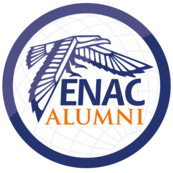News

Rafael BRAGA DE MELO, MSAM14, civil aviation regulation specialst, ANAC (Brazil)
"Take a short break with ENAC Alumni summer issue and discover articles from our previous mag"
What is your pre-ENAC background ? How did you get inspired to become a civil engineer ?
Before ENAC, I studied Civil Engineering at University of Brasilia – UnB, and once I decided to work in the public sector I took a specialization in Public Management. The decision to study civil engineering was very natural to me. First, I can say that during high school, my favorite subjects were the ones more related to mathematics, and I was very curious about everything concerning physic, such as mechanics, heat, magnetism and electricity. However, probably the main reason why I have become a civil engineer is the fact that my father, whose life story I am very proud of, inspired me. He is also a civil engineer who studied in the same university as me. When I was born, he was still at university so I had the chance to visit as a baby what would then become my future university. I grew up following my father around in the construction sites which he was in charge of, and observing how the machines work, watching the buildings grow, the organization of the processes, all of this was exciting as well as challenging for me, and since then I have been passionate about civil engineer.
How did you join the public sector ? What were your missions for the Dept. of Tourism and at Caixa Federal ?
As I said before, my aim was initially to work in construction sites, and that was what I did. After a great experience being an intern in a construction company, I was hired to work with what drove me to the engineering area: building edifices. It was very stimulating in the beginning: many negotiations with suppliers and employees, working outdoors, managing projects, planning the work.
However, after some time I felt that I should be doing more, something that would affect more people. I was then was approved in some public contests to work at different departments of the public sector, but always as an engineer. At first, I worked at the Ministry of Tourism where I was the coordinator of a program called PRODETUR/NE II. This program included investments from Inter-American Development Bank – IDB and the Brazilian government, which sought to promote the sustainable development of tourism in the northeast region of Brazil by improving the quality of life of local communities and at the same time creating a favorable environment for new investments. With the help of consultants, I monitored and oversaw the application of such investments in activities that encompassed professional and business training and public infrastructure, such as regional airports, roads, destination of solid waste, water and sanitation, among others.

After that, I started to work at Caixa Econômica Federal - CEF, a public bank in Brazil. At CEF I worked in the department of sustainable development, and one of the most challenging missions was to develop social, economic and financial indicators regarding all Brazilian cities aiming to provide the appropriate solutions offered by the bank to government clients.
How did you join aviation – and ANAC ? Can you explain your current role within the agency ?
In 2010, I was selected through a public contest to work with aviation at the Brazilian Civil Aviation Authority – ANAC. Aviation was not part of my plans at first, but the challenge to work in this exciting and important field of transportation called my attention. At ANAC I manage the concession agreements regarding the recent airport privatizations (since 2012, 10 airports were privatized in Brazil).
At first, I took part in activities related to investments and services, such as monitoring and overseeing of short and long-term investments, planning of the privatized airports as well as assessing the need for expansions or adaptations of airport infrastructure. In the past few years, I have been dedicated to airport quality service and the review of indicators and incentives for a better service delivered by the airport operators.
My experience in aviation during this period has been rewarding, as I feel that the decisions about the airport regulations have managed to improve considerably the experience of the passengers at the Brazilian airports in recent years.

How did you hear about ENAC ?
In 2013, ANAC and DGAC signed a Memorandum of Understanding (MoU) in which it was defined as a scope of cooperation, among others, the participation of ANAC employees in courses taught at ENAC. Among the courses available, ANAC was interested in the Advanced Master Airport in Management. As it was related to my duties, I applied and was selected to participate in the program. ANAC staff members already knew about ENAC because a group had had the opportunity to study at ENAC through an agreement between Brazil, France and the Institut Aéronautique et Spatial – IAS.
What did you appreciate the most at ENAC ? What was the most valuable learning that you got during the Master’s program ?
It is difficult to say what I appreciated the most at ENAC. I would say that everything was very interesting and enriching. However, the exchange of knowledge and experiences with ENAC researchers and living and studying with people with different worldviews was a paramount. As a result of this, I can say that accepting and respecting the differences between people from different backgrounds and cultures is one of the most valuable learning lessons that I got during the Master’s program, what is essential considering the global civil aviation community and for our life in general.

Can you tell us more about your final internship ?
I took my internship at Groupe ADP. My final study project dealt with the determination of the required apron size in long-term master planning in regards to a balanced airport capacity. The study was based on an innovative approach, regarding the linear aircraft parking stand frontage productivity. As a result, a diagram was prepared to enable an expeditious assessment of the apron needs for a future terminal. In addition, one of the main findings of the study is related to a possible gain of about 35% in efficiency considering the use of contact stands based on improvements of some operation procedures. Finally, based on that, different alternatives regarding the estimation of the needs of aircraft parking stand frontage for a future Terminal 4 at Paris-Charles de Gaulle Airport were presented.
I would like to take this opportunity to express my special thanks and gratitude to my tutor at Groupe ADP, Mr. Dominique Chavanne, to Ms. Sophie Mercieca for her availability for countless meetings and for all the data and information provided, and to all the managers of CDG’s terminals that helped me by answering several questions about operations at the airport.
Back to Brazil, is the ENAC degree a real value added for your daily work and your career ?
The Advanced Master in Airport Management programme had a broad theoretical and practical curriculum that has been of fundamental importance to my assignments at ANAC. As I work with regulations, it is crucial to understand the process and challenges regarding airport management. Indeed, the classes at ENAC and my internship at Groupe ADP added to the efforts made by the Agency to fulfill its mission to guarantee to all Brazilians the safety and excellence of civil aviation.

What are the current “hot topics” for ANAC ?
The current hot topics at ANAC regarding the airport economic regulation is about the new set of airport privatizations, expected to occur in 2018, that will include smaller airports. This is particularly challenging since this will use a different system from our previous experience, requiring new studies of rules to be adopted and international benchmarking analysis. In addition, I can mention the review of the concession agreements taking into consideration indicators of quality of service (Factor Q) and the methodology to define the factor related to airport efficiency (Factor X) - both factors are expected to be revised every 5 years. Also, there may be changes in the airport tariff model - price cap versus revenue cap versus no regulation – for the following airport privatizations. Besides the airport economic regulation, every 2 years ANAC defines a regulatory agenda, and for 2017/2018 I would like to highlight the definition of requirements for certification and surveillance of UAV operators - unmanned aerial vehicle, and the definition of operational requirements for certification and continued surveillance of flight simulators that serve for the qualification and qualification of pilots, among others.
Brasilia or Toulouse… what is your favorite city ?
Brasilia and Toulouse are very beautiful and well-organized cities, each one with their own unique characteristics. On one hand, Toulouse is 2000 years old and it has a lot of history, art and culture; the downtown is very well preserved and pedestrian-friendly, the cuisine is rich (I miss the “cassoulet” and the “pain au chocolat”), people are friendly, Canal du Midi is fascinating and it is the largest centre for aerospace in all Europe. On the other hand, Brasilia was founded on April 21, 1960 to serve as the new national capital. Because of this, Brasilia gathered people from all parts of the country, so here we can find a melting pot of Brazilian cultures. It is a planned city with modern architecture, large avenues and the sky is delightful. Finally (and probably the most curious fact), Brasilia was designed as an airplane shape, so I guess my destiny is really to live here and work with aviation. All of this makes Brasilia a unique city in the world. So, I can say that I love Toulouse, but my favorite city is Brasilia.
Santos Dumont or Clement Ader… in your opinion, who was first in flight ?

It is a tough question and involves a nationalist discussion. What I can say is that Alberto Santos Dumont, the father of aviation in Brazil, was the first to perform a public flight, to take off without any external assistance and then land safely, satisfying all the criteria of the Federation Aéronautique International (FAI) as the world's first airplane. It was on November 12, 1906 when Santos-Dumont flew a kite-like contraption with boxy wings called the 14-Bis on the surroundings of Paris - Bagatelle. Despite these discussions, what matters is that numerous inventors were working on a way to fly at that time, and each one has contributed for the evolution of aviation.
About the author
 |
Rafael Braga de Melo is a specialist in civil aviation regulation at the Brazilian Civil Aviation Authority - ANAC, where he strives to improve the passengers’ experience at airports. Born and raised in Brasilia, he graduated from University of Brasilia, with a Bachelor degree in Civil Engineering. He also studied airport management at ENAC – Toulouse, and completed his programme interning at ADP in Paris. He is passionate about traveling, meeting people and learning about different cultures. He has also lived in Madrid and Rio de Janeiro. Father of an amazing girl. |
Find the whole file "The ENAC, an international school" in the Mag#21 of ENAC Alumni

















No comment
Log in to post comment. Log in.